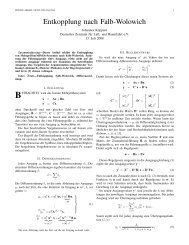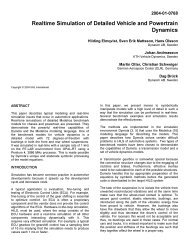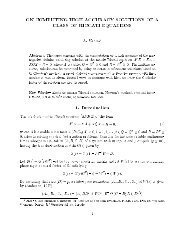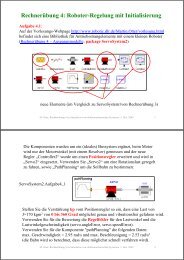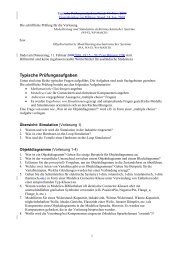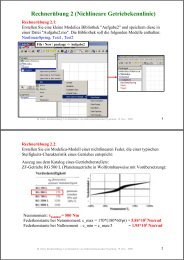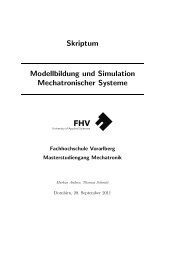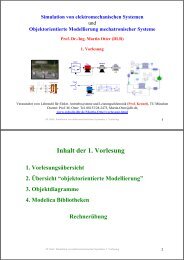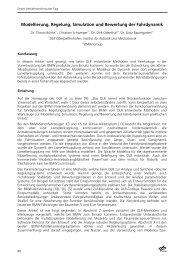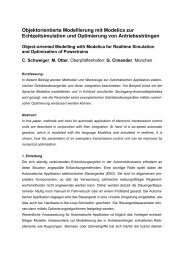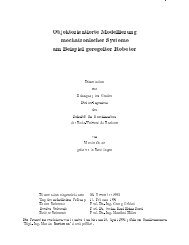Advances and Challenges in Linear Control Systems, Rome, Italy
Advances and Challenges in Linear Control Systems, Rome, Italy
Advances and Challenges in Linear Control Systems, Rome, Italy
You also want an ePaper? Increase the reach of your titles
YUMPU automatically turns print PDFs into web optimized ePapers that Google loves.
Periodic control challenges Computational detours New computational paradigms Algorithms & Open problems<br />
Computational issues for l<strong>in</strong>ear periodic<br />
systems - paradigms, algorithms, open<br />
problems<br />
Andreas Varga<br />
German Aerospace Center (DLR)<br />
Symposium on <strong>Advances</strong> <strong>and</strong> <strong>Challenges</strong> <strong>in</strong> L<strong>in</strong>ear <strong>Control</strong><br />
<strong>Systems</strong> – <strong>Rome</strong>, <strong>Italy</strong>, March 19, 2012<br />
On the occasion of 70th birthday of Osvaldo Maria Grasselli
Periodic control challenges Computational detours New computational paradigms Algorithms & Open problems<br />
Outl<strong>in</strong>e<br />
periodic control challenges<br />
computational detours<br />
new computational paradigms<br />
algorithms & open computational problems
Periodic control challenges Computational detours New computational paradigms Algorithms & Open problems<br />
Satellite attitude control<br />
L<strong>in</strong>earized LEO satellite dynamics with magnetic actuation<br />
ẋ(t) = Ax(t) + B(t)u(t)<br />
y(t) = Cx(t)<br />
x(t) ∈ R 4 , u(t) ∈ R 2<br />
y(t) ∈ R 2<br />
• A has only imag<strong>in</strong>ary eigenvalues, B(t) is T -periodic matrix
Periodic control challenges Computational detours New computational paradigms Algorithms & Open problems<br />
Satellite attitude control<br />
L<strong>in</strong>earized LEO satellite dynamics with magnetic actuation<br />
ẋ(t) = Ax(t) + B(t)u(t)<br />
y(t) = Cx(t)<br />
x(t) ∈ R 4 , u(t) ∈ R 2<br />
y(t) ∈ R 2<br />
• A has only imag<strong>in</strong>ary eigenvalues, B(t) is T -periodic matrix<br />
Discrete-time periodic output feedback stabilization<br />
For a sampl<strong>in</strong>g period ∆, stabilize the discretized<br />
N = T /∆–periodic system<br />
x((k + 1)∆) = A k x(k∆) + B k u(k∆)<br />
y(k∆) = Cx(k∆)<br />
with A k = exp(A∆), B k = ∫ (k+1)∆<br />
k∆<br />
e [A(k+1)∆−τ] B(τ)dτ, us<strong>in</strong>g<br />
the periodic output feedback u(k∆) = F k y(k∆) .
Periodic control challenges Computational detours New computational paradigms Algorithms & Open problems<br />
Satellite attitude control<br />
L<strong>in</strong>earized LEO satellite dynamics with magnetic actuation<br />
ẋ(t) = Ax(t) + B(t)u(t)<br />
y(t) = Cx(t)<br />
x(t) ∈ R 4 , u(t) ∈ R 2<br />
y(t) ∈ R 2<br />
• A has only imag<strong>in</strong>ary eigenvalues, B(t) is T -periodic matrix<br />
Discrete-time periodic output feedback stabilization<br />
For a sampl<strong>in</strong>g period ∆, stabilize the discretized<br />
N = T /∆–periodic system<br />
x((k + 1)∆) = A k x(k∆) + B k u(k∆)<br />
y(k∆) = Cx(k∆)<br />
with A k = exp(A∆), B k = ∫ (k+1)∆<br />
k∆<br />
e [A(k+1)∆−τ] B(τ)dτ, us<strong>in</strong>g<br />
the periodic output feedback u(k∆) = F k y(k∆) .<br />
Challenge<br />
T =5400 s, ∆=10 s ⇒ very large period N =540!
Periodic control challenges Computational detours New computational paradigms Algorithms & Open problems<br />
W<strong>in</strong>d turb<strong>in</strong>e disturbance attenuation<br />
Closed-loop l<strong>in</strong>ear FE w<strong>in</strong>d turb<strong>in</strong>e blade control system<br />
ẋ(t) = A(t)x(t) + E(t)d(t)<br />
x(t) ∈ R n ,<br />
y(t) = C(t)x(t) + F(t)d(t)<br />
• A(t) is T -periodic; only A(i∆), i = 0, . . . , K available<br />
Typical values: n = 1200, T = 6 s, ∆=0.2 s, K = 30
Periodic control challenges Computational detours New computational paradigms Algorithms & Open problems<br />
W<strong>in</strong>d turb<strong>in</strong>e disturbance attenuation<br />
Closed-loop l<strong>in</strong>ear FE w<strong>in</strong>d turb<strong>in</strong>e blade control system<br />
ẋ(t) = A(t)x(t) + E(t)d(t)<br />
x(t) ∈ R n ,<br />
y(t) = C(t)x(t) + F(t)d(t)<br />
• A(t) is T -periodic; only A(i∆), i = 0, . . . , K available<br />
Typical values: n = 1200, T = 6 s, ∆=0.2 s, K = 30<br />
Floquet stability analysis<br />
Compute the eigenvalues of the state-transition matrix Φ A (T , 0)<br />
<strong>and</strong> check their stability.
Periodic control challenges Computational detours New computational paradigms Algorithms & Open problems<br />
W<strong>in</strong>d turb<strong>in</strong>e disturbance attenuation<br />
Closed-loop l<strong>in</strong>ear FE w<strong>in</strong>d turb<strong>in</strong>e blade control system<br />
ẋ(t) = A(t)x(t) + E(t)d(t)<br />
x(t) ∈ R n ,<br />
y(t) = C(t)x(t) + F(t)d(t)<br />
• A(t) is T -periodic; only A(i∆), i = 0, . . . , K available<br />
Typical values: n = 1200, T = 6 s, ∆=0.2 s, K = 30<br />
Floquet stability analysis<br />
Compute the eigenvalues of the state-transition matrix Φ A (T , 0)<br />
<strong>and</strong> check their stability.<br />
Challenge<br />
Many eigenvalues have nearly unit magnitudes ⇒ accurate<br />
eigenvalue computation difficult because of very large state<br />
dimension n =1200!
Periodic control challenges Computational detours New computational paradigms Algorithms & Open problems<br />
Vibration <strong>and</strong> noise reduction <strong>in</strong> helicopter forward flight<br />
L<strong>in</strong>earized helicopter model <strong>in</strong> forward flight<br />
ẋ(t) = A(t)x(t) + B(t)u(t) + E(t)d(t)<br />
x(t) ∈ R n ,<br />
y(t) = C(t)x(t) + D(t)u(t) + F(t)d(t)<br />
• A(t), B(t), E(t), C(t), D(t), F(t) are T -periodic;<br />
• only A(i∆), B(i∆), C(i∆), D(i∆), . . . i = 0, . . . , K available<br />
Typical values: n = 56, T = 0.15 s, ∆=0.003 s, K = 50
Periodic control challenges Computational detours New computational paradigms Algorithms & Open problems<br />
Vibration <strong>and</strong> noise reduction <strong>in</strong> helicopter forward flight<br />
L<strong>in</strong>earized helicopter model <strong>in</strong> forward flight<br />
ẋ(t) = A(t)x(t) + B(t)u(t) + E(t)d(t)<br />
x(t) ∈ R n ,<br />
y(t) = C(t)x(t) + D(t)u(t) + F(t)d(t)<br />
• A(t), B(t), E(t), C(t), D(t), F(t) are T -periodic;<br />
• only A(i∆), B(i∆), C(i∆), D(i∆), . . . i = 0, . . . , K available<br />
Typical values: n = 56, T = 0.15 s, ∆=0.003 s, K = 50<br />
Individual blade control for noise <strong>and</strong> vibration reduction<br />
Use a periodic controller based on the <strong>in</strong>ternal model pr<strong>in</strong>ciple<br />
parameterized by constant ga<strong>in</strong>s
Periodic control challenges Computational detours New computational paradigms Algorithms & Open problems<br />
Vibration <strong>and</strong> noise reduction <strong>in</strong> helicopter forward flight<br />
L<strong>in</strong>earized helicopter model <strong>in</strong> forward flight<br />
ẋ(t) = A(t)x(t) + B(t)u(t) + E(t)d(t)<br />
x(t) ∈ R n ,<br />
y(t) = C(t)x(t) + D(t)u(t) + F(t)d(t)<br />
• A(t), B(t), E(t), C(t), D(t), F(t) are T -periodic;<br />
• only A(i∆), B(i∆), C(i∆), D(i∆), . . . i = 0, . . . , K available<br />
Typical values: n = 56, T = 0.15 s, ∆=0.003 s, K = 50<br />
Individual blade control for noise <strong>and</strong> vibration reduction<br />
Use a periodic controller based on the <strong>in</strong>ternal model pr<strong>in</strong>ciple<br />
parameterized by constant ga<strong>in</strong>s<br />
Challenge<br />
High computational effort required when employ<strong>in</strong>g an<br />
optimization-based tun<strong>in</strong>g procedure for closed-loop<br />
stabilization: each function evaluation <strong>in</strong>volves solv<strong>in</strong>g a pair of<br />
periodic Lyapunov/Sylvester equations
Periodic control challenges Computational detours New computational paradigms Algorithms & Open problems<br />
Multi-rate sampled system analysis <strong>and</strong> design<br />
Multirate sampl<strong>in</strong>g of cont<strong>in</strong>uous-time systems<br />
ẋ(t) = Ax(t) + Bu(t)<br />
y(t) = Cx(t) + Du(t)<br />
For given ∆, sample <strong>in</strong>put u j with sampl<strong>in</strong>g period k j ∆ <strong>and</strong><br />
output y i with sampl<strong>in</strong>g period l i ∆ (k j , l i <strong>in</strong>tegers).
Periodic control challenges Computational detours New computational paradigms Algorithms & Open problems<br />
Multi-rate sampled system analysis <strong>and</strong> design<br />
Multirate sampl<strong>in</strong>g of cont<strong>in</strong>uous-time systems<br />
ẋ(t) = Ax(t) + Bu(t)<br />
y(t) = Cx(t) + Du(t)<br />
For given ∆, sample <strong>in</strong>put u j with sampl<strong>in</strong>g period k j ∆ <strong>and</strong><br />
output y i with sampl<strong>in</strong>g period l i ∆ (k j , l i <strong>in</strong>tegers).<br />
M<strong>in</strong>imal discretized periodic system<br />
x k+1 = A k x k + B k u k<br />
y k = C k x k + D k u k<br />
A k ∈ IR n k+1×n k<br />
, B k ∈ IR n }<br />
k+1×m<br />
C k ∈ IR p×n k<br />
, D k ∈ IR p×m – N-periodic matrices
Periodic control challenges Computational detours New computational paradigms Algorithms & Open problems<br />
Multi-rate sampled system analysis <strong>and</strong> design<br />
Multirate sampl<strong>in</strong>g of cont<strong>in</strong>uous-time systems<br />
ẋ(t) = Ax(t) + Bu(t)<br />
y(t) = Cx(t) + Du(t)<br />
For given ∆, sample <strong>in</strong>put u j with sampl<strong>in</strong>g period k j ∆ <strong>and</strong><br />
output y i with sampl<strong>in</strong>g period l i ∆ (k j , l i <strong>in</strong>tegers).<br />
M<strong>in</strong>imal discretized periodic system<br />
x k+1 = A k x k + B k u k<br />
y k = C k x k + D k u k<br />
A k ∈ IR n k+1×n k<br />
, B k ∈ IR n }<br />
k+1×m<br />
C k ∈ IR p×n k<br />
, D k ∈ IR p×m – N-periodic matrices<br />
Challenge<br />
Time-vary<strong>in</strong>g state dimensions!
Periodic control challenges Computational detours New computational paradigms Algorithms & Open problems<br />
Computational detours<br />
Solv<strong>in</strong>g LTP computational problems us<strong>in</strong>g LTI techniques<br />
1 Form a LTI lifted system representation<br />
2 Apply computational methods for LTI systems<br />
3 Recover the LTP representation of the solution<br />
LTI – l<strong>in</strong>ear time-<strong>in</strong>variant<br />
LTP – l<strong>in</strong>ear time-periodic
Periodic control challenges Computational detours New computational paradigms Algorithms & Open problems<br />
Computational detours<br />
Solv<strong>in</strong>g LTP computational problems us<strong>in</strong>g LTI techniques<br />
1 Form a LTI lifted system representation<br />
2 Apply computational methods for LTI systems<br />
3 Recover the LTP representation of the solution<br />
LTI – l<strong>in</strong>ear time-<strong>in</strong>variant<br />
LTP – l<strong>in</strong>ear time-periodic<br />
Caveat<br />
Us<strong>in</strong>g lift<strong>in</strong>g based computational techniques is a bad practice:<br />
worsened condition<strong>in</strong>g, large dimensions, numerical <strong>in</strong>stability<br />
⇒ Work<strong>in</strong>g on orig<strong>in</strong>al data must be always preferred!
Periodic control challenges Computational detours New computational paradigms Algorithms & Open problems<br />
D1. St<strong>and</strong>ard discrete-time lift<strong>in</strong>g (1)<br />
St<strong>and</strong>ard periodic system:<br />
x k+1 = A k x k + B k u k<br />
y k = C k x k + D k u k<br />
Lifted signals: (Meyer & Burrus, 1975)<br />
Lifted system:<br />
uk L(h) = [uT (k + hN) · · · u T (k + hN + N − 1)] T ,<br />
yk L(h) = [y T (k + hN) · · · y T (k + hN + N − 1)] T ,<br />
xk L (h) = x(k + hN)<br />
x L k (h + 1) = F L k x L k (h) + GL k uL k (h)<br />
y L k (h) = HL k x L k (h) + LL k uL k (h)
Periodic control challenges Computational detours New computational paradigms Algorithms & Open problems<br />
D1. St<strong>and</strong>ard discrete-time lift<strong>in</strong>g (2)<br />
Transition matrix: Φ A (j, i) := A j−1 · · · A i+1 A i ,<br />
Lifted system matrices:<br />
Fk L = Φ A (k + N, k)<br />
Gk L = [ ⎡Φ A (k + N, k + 1)B k · · · B k+N−1 ⎤ ]<br />
H L k<br />
=<br />
L L k<br />
=<br />
⎢<br />
⎣<br />
⎡<br />
⎢<br />
⎣<br />
C k<br />
.<br />
C k+N−1 Φ A (k + N − 1, k)<br />
⎤<br />
D k 0 · · · 0<br />
∗ D k · · · 0<br />
.<br />
. . ..<br />
⎥<br />
. ⎦<br />
∗ ∗ · · · D k<br />
Φ A (i, i) := I ni<br />
⎥<br />
⎦
Periodic control challenges Computational detours New computational paradigms Algorithms & Open problems<br />
D1. St<strong>and</strong>ard discrete-time lift<strong>in</strong>g (2)<br />
Transition matrix: Φ A (j, i) := A j−1 · · · A i+1 A i ,<br />
Lifted system matrices:<br />
Fk L = Φ A (k + N, k)<br />
Gk L = [ ⎡Φ A (k + N, k + 1)B k · · · B k+N−1 ⎤ ]<br />
H L k<br />
=<br />
L L k<br />
=<br />
Disadvantages<br />
⎢<br />
⎣<br />
⎡<br />
⎢<br />
⎣<br />
C k<br />
.<br />
C k+N−1 Φ A (k + N − 1, k)<br />
⎤<br />
D k 0 · · · 0<br />
∗ D k · · · 0<br />
.<br />
. . ..<br />
⎥<br />
. ⎦<br />
∗ ∗ · · · D k<br />
– worsened problem condition<strong>in</strong>g<br />
– reliable computations not possible<br />
Φ A (i, i) := I ni<br />
⎥<br />
⎦
Periodic control challenges Computational detours New computational paradigms Algorithms & Open problems<br />
D2. Stacked discrete-time lift<strong>in</strong>g (1)<br />
Descriptor periodic system:<br />
E k x k+1 = A k x k + B k u k<br />
y k = C k x k + D k u k<br />
E k ∈ R ν k ×n k+1<br />
, A k ∈ R ν k ×n k<br />
, B k ∈ R ν k ×m k<br />
, C k ∈ R p k ×n k<br />
,<br />
D k ∈ R p k ×m k<br />
– N-periodic <strong>and</strong> ∑ N<br />
k=1 ν k = ∑ N<br />
k=1 n k<br />
Lifted signals: (Grasselli, 1991)<br />
Lifted system:<br />
u L k (h) = [uT (k + hN) · · · u T (k + hN + N − 1)] T ,<br />
y L k (h) = [y T (k + hN) · · · y T (k + hN + N − 1)] T ,<br />
x S k (h) = [x T (k + hN) · · · x T (k + hN + N − 1)] T<br />
Ek Sx k S(h + 1) = F k Sx k S(h) + GS k uL k (h)<br />
yk L(h) = HS k x k S(h) + LS k uL k (h)
Periodic control challenges Computational detours New computational paradigms Algorithms & Open problems<br />
D2. Stacked discrete-time lift<strong>in</strong>g (2)<br />
Lifted system matrices:<br />
⎡<br />
⎤<br />
A k −E k O · · · O<br />
. O .. . .. . .. .<br />
Fk<br />
S − λE k S = . . .. . .. . .. O<br />
⎢<br />
.<br />
⎣ O .. ⎥<br />
Ak+N−2 −E k+N−2<br />
⎦<br />
−zE k+N−1 O · · · O A k+N−1<br />
G S k = diag {B k, . . . , B k+N−1 }<br />
H S k = diag {C k, . . . , C k+N−1 }<br />
L S k = diag {D k, . . . , D k+N−1 }
Periodic control challenges Computational detours New computational paradigms Algorithms & Open problems<br />
D2. Stacked discrete-time lift<strong>in</strong>g (2)<br />
Lifted system matrices:<br />
⎡<br />
⎤<br />
A k −E k O · · · O<br />
. O .. . .. . .. .<br />
Fk<br />
S − λE k S = . . .. . .. . .. O<br />
⎢<br />
.<br />
⎣ O .. ⎥<br />
Ak+N−2 −E k+N−2<br />
⎦<br />
−zE k+N−1 O · · · O A k+N−1<br />
Disadvantages<br />
G S k = diag {B k, . . . , B k+N−1 }<br />
H S k = diag {C k, . . . , C k+N−1 }<br />
L S k = diag {D k, . . . , D k+N−1 }<br />
– excessive computational effort<br />
– structure not exploited <strong>and</strong> not preserved<br />
– delicate f<strong>in</strong>al step (periodic descriptor realization)
Periodic control challenges Computational detours New computational paradigms Algorithms & Open problems<br />
D3. Comput<strong>in</strong>g periodic solutions of matrix differential equations<br />
Periodic Riccati differential equation<br />
Ẋ(t) = A(t)X(t)+X(t)A T (t)+R(t)−X(t)Q(t)X(t)<br />
Periodic Lyapunov differential equation<br />
Ẋ(t) = A(t)X(t) + X(t)A T (t) + C(t)<br />
Periodic Sylvester differential equation<br />
Ẋ(t) = A(t)X(t) + X(t)B(t) + C(t)<br />
A(t), B(t), C(t), R(t), Q(t) – T -periodic matrices (given)<br />
X(t) – T -periodic (to be computed)
Periodic control challenges Computational detours New computational paradigms Algorithms & Open problems<br />
D3. Periodic generator method<br />
Fact: For the T -periodic solution X(t), X(0) fulfills appropriate<br />
st<strong>and</strong>ard algebraic Riccati, Lyapunov or Sylvester equations!<br />
Approach:<br />
1 Compute X(0) by solv<strong>in</strong>g the algebraic matrix equation<br />
us<strong>in</strong>g st<strong>and</strong>ard techniques<br />
2 Integrate the differential equation to compute the solution<br />
on [0, T ].
Periodic control challenges Computational detours New computational paradigms Algorithms & Open problems<br />
D3. Periodic generator method<br />
Fact: For the T -periodic solution X(t), X(0) fulfills appropriate<br />
st<strong>and</strong>ard algebraic Riccati, Lyapunov or Sylvester equations!<br />
Approach:<br />
1 Compute X(0) by solv<strong>in</strong>g the algebraic matrix equation<br />
us<strong>in</strong>g st<strong>and</strong>ard techniques<br />
2 Integrate the differential equation to compute the solution<br />
on [0, T ].<br />
Expected difficulties<br />
– unstable A(t) leads to unstable <strong>in</strong>tegration of ODEs<br />
– severe accuracy losses expected for large T
Periodic control challenges Computational detours New computational paradigms Algorithms & Open problems<br />
D3. A challeng<strong>in</strong>g example (Colaneri)<br />
Computation of characteristic exponents<br />
[<br />
]<br />
0 1<br />
A(t) =<br />
, with α(t) = 15 + 5 s<strong>in</strong> t <strong>and</strong> T = 2π.<br />
−2 ˙α(t) 6 − 2α(t)<br />
[ ]<br />
1 0<br />
With P(t)=<br />
, perform the Lyapunov transformation<br />
6−2 α (t) 1<br />
[ ]<br />
Ã(t) := P −1 (t)A(t)P(t) − P −1 (t)Ṗ(t) = 6 − 2α(t) 1<br />
0 0<br />
⇒ A(t) has characteristic exponents: µ 1 = 0 <strong>and</strong> µ 2 = −24.<br />
Us<strong>in</strong>g numerical <strong>in</strong>tegration with reltol = 10 −10 to determ<strong>in</strong>e<br />
Φ A (T , 0), we get for µ = 1 T log λ(Φ A(T , 0)):<br />
µ 1 = −3.9 · 10 −7 , µ 2 = −2.05... ⇒ No accurate digits <strong>in</strong> µ 2 !!!
Periodic control challenges Computational detours New computational paradigms Algorithms & Open problems<br />
Satisfactory algorithms<br />
Ma<strong>in</strong> requirements<br />
– general (e.g., time-vary<strong>in</strong>g dimensions)<br />
– numerically stable<br />
– efficient ⇔ complexity O(Nn 3 )
Periodic control challenges Computational detours New computational paradigms Algorithms & Open problems<br />
Satisfactory algorithms<br />
Ma<strong>in</strong> requirements<br />
– general (e.g., time-vary<strong>in</strong>g dimensions)<br />
– numerically stable<br />
– efficient ⇔ complexity O(Nn 3 )<br />
Structure exploit<strong>in</strong>g "fast" algorithms<br />
– exploit zero structure of lifted representations<br />
– k<strong>in</strong>d of (weak) numerical stability can be often proven<br />
– lowest computational complexity
Periodic control challenges Computational detours New computational paradigms Algorithms & Open problems<br />
Satisfactory algorithms<br />
Ma<strong>in</strong> requirements<br />
– general (e.g., time-vary<strong>in</strong>g dimensions)<br />
– numerically stable<br />
– efficient ⇔ complexity O(Nn 3 )<br />
Structure exploit<strong>in</strong>g "fast" algorithms<br />
– exploit zero structure of lifted representations<br />
– k<strong>in</strong>d of (weak) numerical stability can be often proven<br />
– lowest computational complexity<br />
Structure preserv<strong>in</strong>g algorithms<br />
– preserve cyclic structure of lifted representations<br />
– structurally (strong) backward stable algorithms<br />
– less efficient than "fast" methods
Periodic control challenges Computational detours New computational paradigms Algorithms & Open problems<br />
New computational paradigms<br />
P1. Manipulation of matrix products without form<strong>in</strong>g them<br />
P2. Reduction of large structured pencils without form<strong>in</strong>g them<br />
<strong>and</strong> exploit<strong>in</strong>g structure ⇒ structure exploit<strong>in</strong>g (fast)<br />
algorithms<br />
P3. Reduction of large structured pencils without form<strong>in</strong>g them<br />
<strong>and</strong> preserv<strong>in</strong>g their structure ⇒ structure preserv<strong>in</strong>g<br />
(strong numerically stable) algorithms<br />
P4. Employ<strong>in</strong>g multiple shoot<strong>in</strong>g methods <strong>in</strong>stead periodic<br />
generator based approaches
Periodic control challenges Computational detours New computational paradigms Algorithms & Open problems<br />
P1. Computation of eigenvalues of periodic systems<br />
Problem: Given an N-periodic matrix A k ∈ R n×n , compute the<br />
eigenvalues of<br />
Φ A (N + 1, 1) := A N · · · A 2 A 1<br />
Periodic real Schur form (PRSF): For given N-periodic A k<br />
there exists orthogonal N-periodic Q k s.t.<br />
à k = Q T k+1 A kQ k ,<br />
k = 1, . . . , N<br />
is <strong>in</strong> PRSF (Ã1 – quasi-upper triangular, Ã2, . . ., ÃN upper<br />
triangular) ⇒<br />
Q T 1 Φ A(N + 1, 1)Q 1 = ΦÃ(N + 1, 1) = ÃN · · · Ã2Ã1<br />
is <strong>in</strong> a real Schur form!
Periodic control challenges Computational detours New computational paradigms Algorithms & Open problems<br />
P1. Example (cont.)<br />
Alternative approach<br />
For N > 1, def<strong>in</strong>e t i = iT /N for i = 1, . . . , N. Compute the<br />
eigenvalues of Φ(T , 0) via the periodic real Schur form of<br />
Φ(T , 0) = Φ(t N , t N−1 ) · · · Φ(t 2 , t 1 )Φ(t 1 , 0)<br />
Results: N |µ 1 | µ 2<br />
1 3.9 · 10 −7 -2.05...<br />
2 2.6 · 10 −7 complex !!<br />
5 4.5 · 10 −7 -11.2653<br />
10 2.1 · 10 −9 -19.7407<br />
25 7.7 · 10 −12 -23.9921<br />
50 2.4 · 10 −15 -23.9982<br />
100 2.7 · 10 −15 -23.99995<br />
200 3.2 · 10 −15 -23.9999993<br />
500 1.9 · 10 −14 -23.999999998<br />
10-digits accuracy possible by exploit<strong>in</strong>g structure!
Periodic control challenges Computational detours New computational paradigms Algorithms & Open problems<br />
P2. Zeros-based analysis of periodic descriptor systems<br />
N-periodic descriptor system:<br />
E k x k+1 = A k x k + B k u k<br />
y k = C k x k + D k u k<br />
, x k ∈ R n k<br />
Poles: zeros of S(z) := Fk<br />
S − zE k<br />
S<br />
[ F<br />
S<br />
Zeros: zeros of S(z) := k<br />
− zEk S Gk<br />
S<br />
Reachability/Stabilizability:<br />
<strong>in</strong>put decoupl<strong>in</strong>g zeros ⇔ zeros of S(z) := [ Fk S − zE k S GS k ]<br />
Observability/Detectability:<br />
[ F<br />
S<br />
output decoupl<strong>in</strong>g zeros ⇔ zeros of S(z) := k<br />
− zEk<br />
S ]<br />
H S k<br />
L S k<br />
]<br />
H S k
Periodic control challenges Computational detours New computational paradigms Algorithms & Open problems<br />
P2. Fast structure exploit<strong>in</strong>g algorithm for zeros computation<br />
Computational approach: Determ<strong>in</strong>e orthogonal Q <strong>and</strong> Z<br />
such that<br />
[ ]<br />
R ∗<br />
QS(z)Z =<br />
0 ˜F − zẼ<br />
where:<br />
R has full row rank <strong>and</strong> size O (N max{n k })<br />
˜F − zẼ has the same f<strong>in</strong>ite/<strong>in</strong>f<strong>in</strong>ite zeros as S(z) <strong>and</strong> size O (n k)<br />
Properties:<br />
orthogonal block row compressions ⇒ certa<strong>in</strong> k<strong>in</strong>d of<br />
weak numerical stability can be proven<br />
efficient computations ⇔ fast algorithm<br />
zero-nonzero structure of S(z) destroyed
Periodic control challenges Computational detours New computational paradigms Algorithms & Open problems<br />
P3. Structure preserv<strong>in</strong>g analysis<br />
N-periodic pairs: (S k , T k ) :=<br />
([ ]<br />
Ak B k<br />
,<br />
C k D k<br />
[<br />
Ek O<br />
])<br />
O O<br />
Alternative system pencil:<br />
⎡<br />
⎤<br />
S k −T k O · · · O<br />
O S k+1 −T k+1 · · · O<br />
˜S k (z) :=<br />
.<br />
⎢ . .. . .. . .. .<br />
⎥<br />
⎣ O S k+N−2 −T k + N −2 ⎦<br />
−zT k+N−1 O · · · O S k+N−1<br />
[ F<br />
S<br />
Fact: k<br />
− zEk S Gk<br />
S<br />
structure.<br />
H S k<br />
L S k<br />
]<br />
<strong>and</strong> ˜S k (z) have the same Kronecker
Periodic control challenges Computational detours New computational paradigms Algorithms & Open problems<br />
P3. Structure preserv<strong>in</strong>g reduction to periodic Kronecker-like form<br />
For the N-periodic pair (S k , T k ), determ<strong>in</strong>e orthogonal<br />
N-periodic Q k <strong>and</strong> Z k such that<br />
⎡<br />
B r ⎤<br />
⎡<br />
k Ar k<br />
∗ ∗ ∗<br />
O E O O A ∞ k r ∗ ∗ ∗<br />
k<br />
∗ ∗<br />
Q k S k Z k =<br />
⎢ O O O A f k<br />
∗<br />
⎥<br />
⎣ O O O O A l ⎦ , Q O O Ek ∞ ∗ ∗<br />
kT k Z k+1 =<br />
⎢ O O O Ek f ∗<br />
⎣<br />
k<br />
O O O O E l<br />
O O O O Ck<br />
l k<br />
O O O O O<br />
(a) E r k <strong>in</strong>vertible <strong>and</strong> ( (E r k )−1 A r k , (E r k )−1 B r k)<br />
completely<br />
reachable ⇒ right Kronecker structure<br />
(b) E l k <strong>in</strong>vertible <strong>and</strong> ( C l k , (E l k )−1 A l k)<br />
completely observable<br />
⇒ left Kronecker structure<br />
(c) A ∞ k<br />
<strong>in</strong>vertible <strong>and</strong> (A ∞ k )−1 Ek ∞ . . . (A∞ k+N−1 )−1 Ek+N−1<br />
∞<br />
nilpotent ⇒ (A ∞ k , E k<br />
∞ ) conta<strong>in</strong>s the <strong>in</strong>f<strong>in</strong>ite structure<br />
(d) Ek f <strong>in</strong>vertible ⇒ (Af k , E k f ) conta<strong>in</strong>s the f<strong>in</strong>ite structure<br />
⎤<br />
⎥<br />
⎦
Periodic control challenges Computational detours New computational paradigms Algorithms & Open problems<br />
P4. Multiple shoot<strong>in</strong>g methods<br />
Basic approach<br />
1 Discretize the cont<strong>in</strong>uous-time problem: for ∆ = T /N, def<strong>in</strong>e<br />
X k := X((k − 1)∆), for k = 1, . . . , N.<br />
2 Compute X 1 , X 2 , ..., X N , s.t. X 1 = X N+1 (i.e., X(0)=X(T ))<br />
3 Integrate the appropriate differential equation to compute the<br />
solution on [(k − 1)∆, k∆], for k = 1, . . . , N.
Periodic control challenges Computational detours New computational paradigms Algorithms & Open problems<br />
P4. Multiple shoot<strong>in</strong>g methods<br />
Basic approach<br />
1 Discretize the cont<strong>in</strong>uous-time problem: for ∆ = T /N, def<strong>in</strong>e<br />
X k := X((k − 1)∆), for k = 1, . . . , N.<br />
2 Compute X 1 , X 2 , ..., X N , s.t. X 1 = X N+1 (i.e., X(0)=X(T ))<br />
3 Integrate the appropriate differential equation to compute the<br />
solution on [(k − 1)∆, k∆], for k = 1, . . . , N.<br />
Computational aspects<br />
computation of suitable transition matrices over small <strong>in</strong>tervals<br />
[(k − 1)∆, k∆] ⇒ unstable or fast dynamics can be h<strong>and</strong>led<br />
solv<strong>in</strong>g appropriate discrete-time periodic Lyapunov, Sylvester or<br />
Riccati equations ⇒ numerically reliable algorithms available<br />
us<strong>in</strong>g structure preserv<strong>in</strong>g <strong>in</strong>tegration (e.g., symplectic, positivity<br />
preserv<strong>in</strong>g ) ⇒ enhanced accuracy for large T<br />
steps 1 & 3 are "embarrass<strong>in</strong>gly" parallelizable ⇒ highly efficient<br />
computations
Periodic control challenges Computational detours New computational paradigms Algorithms & Open problems<br />
P4. Solution of periodic Lyapunov differential equation<br />
1. Discretize the cont<strong>in</strong>uous-time equation: For ∆ := T /N,<br />
X(t) <strong>and</strong> X(t + ∆) are related as<br />
X(t + ∆) = Φ A (t + ∆, t)X(t)Φ T A<br />
(t + ∆, t)+<br />
Φ A (t + ∆, τ)C(τ)Φ T A<br />
(t + ∆, τ)dτ<br />
∫ t+∆<br />
t<br />
2. Solve the discrete-time periodic Lyapunov equation:<br />
X k+1 = F k X k Fk T + W k, k = 1, . . . , N; X N+1 = X 1<br />
where X k = X((k − 1)∆), F k := Φ A (k∆, (k − 1)∆) <strong>and</strong><br />
W k :=<br />
∫ k∆<br />
(k−1)∆<br />
Φ A (k∆, τ) C(τ)Φ T A (k∆, τ) dτ<br />
Parallelization: Step 1 is "embarrass<strong>in</strong>gly" parallelizable!
Periodic control challenges Computational detours New computational paradigms Algorithms & Open problems<br />
Algorithms for discrete-time periodic systems<br />
Basic analysis techniques: poles, zeros, structural<br />
properties, m<strong>in</strong>imal realization, frequency<br />
response, system norms, model reduction.<br />
Basic synthesis techniques: periodic matrix equations<br />
(Lyapunov, Sylvester, Riccati), pole assignment,<br />
stabilization, <strong>in</strong>verses, left/right annihilators,<br />
m<strong>in</strong>imal dynamic covers, proper/stable coprime<br />
factorizations, normalized coprime factorizations.<br />
Synthesis methods: exact fault detection <strong>and</strong> isolation (FDI),<br />
H 2 /H ∞ synthesis techniques, optimal periodic<br />
output feedback
Periodic control challenges Computational detours New computational paradigms Algorithms & Open problems<br />
Contributions – discrete-time<br />
Theory of discrete-time periodic systems: Bittanti, Bolzern,<br />
Colaneri, Grasselli, Longhi, De Nicolao,<br />
Tornambè, Verriest<br />
Product eigenvalue problems: Benner, Bojanczik, Byers,<br />
Hench, Granat, Kågström, Kressner, Sreedhar,<br />
Van Dooren, Varga<br />
Condensed forms, system analysis: Benner, Van Dooren,<br />
Varga<br />
Matrix equations: Benner, Hench, Laub, Kressner, Van<br />
Dooren, Varga<br />
Synthesis problems: Bittanti, Colaneri, Longhi, Varga
Periodic control challenges Computational detours New computational paradigms Algorithms & Open problems<br />
Algorithms for cont<strong>in</strong>uous-time periodic systems<br />
Basic analysis techniques: Floquet-analysis us<strong>in</strong>g multiple<br />
shoot<strong>in</strong>g, system norms, frequency lift<strong>in</strong>g based<br />
methods (e.g., frequency response), discretization<br />
Basic synthesis techniques: multiple shoot<strong>in</strong>g methods for<br />
solv<strong>in</strong>g periodic matrix differential equations<br />
(Lyapunov, Sylvester, Riccati)<br />
Synthesis methods: optimal periodic output feedback,<br />
H 2 /H ∞ synthesis
Periodic control challenges Computational detours New computational paradigms Algorithms & Open problems<br />
Contributions – cont<strong>in</strong>uous-time<br />
Theory of PDEs: Bittanti, Bolzern, Brocket, Colaneri<br />
Periodic systems norms: Bittanti, Colaneri, Hagiwara,<br />
Lampe, Rosenwasser, Zhou<br />
Multiple shoot<strong>in</strong>g based methods: Varga<br />
Relevant discrete-time techniques: Benner, Bojanczik,<br />
Byers, Granat, Guo, Johansson, Hench, Laub, Van<br />
Dooren, Varga<br />
Geometric <strong>in</strong>tegration: Dieci, Hairer, Hench, Kenney, Laub,<br />
Lubich, Warnner
Periodic control challenges Computational detours New computational paradigms Algorithms & Open problems<br />
Open problems – discrete-time<br />
descriptor periodic realization<br />
<strong>in</strong>ner-outer factorization (non-st<strong>and</strong>ard case)<br />
Hankel-norm approximation<br />
solution of exact/approximate model match<strong>in</strong>g problems<br />
solution of approximate FDI synthesis problems<br />
efficient solution of periodic LMIs
Periodic control challenges Computational detours New computational paradigms Algorithms & Open problems<br />
Open problems – cont<strong>in</strong>uous-time<br />
efficient computation of frequency-responses<br />
periodic stabilization <strong>and</strong> pole assignment<br />
solution of periodic differential LMIs<br />
structure exploit<strong>in</strong>g/preserv<strong>in</strong>g algorithms for<br />
frequency-lifted representations<br />
application of cont<strong>in</strong>uous matrix decompositions to solve<br />
various structural problems
Periodic control challenges Computational detours New computational paradigms Algorithms & Open problems<br />
Additional <strong>in</strong>formation<br />
A. Varga <strong>and</strong> P. Van Dooren<br />
Computational methods for periodic systems - an overview,<br />
Prepr. IFAC Workshop on Periodic <strong>Control</strong> <strong>Systems</strong>, Como,<br />
<strong>Italy</strong>, pp. 177–176, 2001.<br />
A. Varga.<br />
A PERIODIC SYSTEMS Toolbox for MATLAB.<br />
Proc. of IFAC 2005 World Congress, Prague, Czech<br />
Republic, 2005.<br />
(available only with<strong>in</strong> cooperation projects)<br />
A. Varga.<br />
An overview of recent developments <strong>in</strong> computational<br />
methods for periodic systems.<br />
Proc. of IFAC Workshop on Periodic <strong>Control</strong> <strong>Systems</strong>, St.<br />
Petersburg, Russia, 2007.



